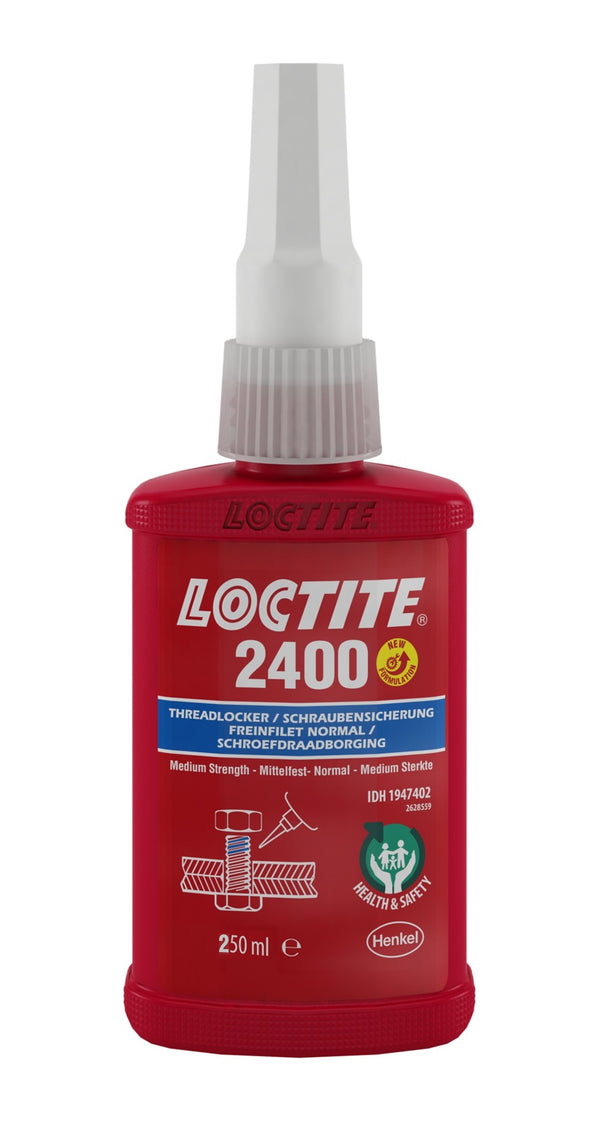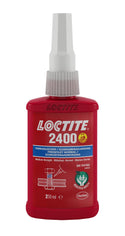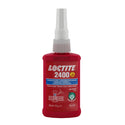LOCTITE® 2400
Anaerobic threadlocker - medium disassembly
LOCTITE® 2400 is a medium strength threadlocker that prevents loosening of parts subjected to vibration. It works on all metals and passive substrates.
The product cures when isolated from air and placed between tightly fitting metal surfaces. The product prevents
loosening of connections and leaks under static and dynamic loads.
LOCTITE® 2400™ reduces the run-off of liquid product.
Applications Usage
LOCTITE® 2400™ is designed to lock and seal threaded fasteners where service disassembly with conventional tools is required.
LOCTITE® 2400™ is particularly suitable for less active surfaces such as stainless steel and zinc lamellar (flake) coated or electro-galvanised surfaces where disassembly with hand tools is required.
- threaded connections
- pump, gearbox or work mounting bolts
- nuts
- pegs
Features and Benefits
- does not contain any hazardous substances "white" safety data sheet
- thixotropic properties of the product
- suitable for surfaces: aluminum, steel, stainless steel, brass
- WRAS approved (BS 6920): 1104507
- regular disassembly of parts for inspection is possible
- prevents self-loosening of parts subjected to vibrations
Typical properties
| Technology | Acrylic |
| Compound | Dimethacrylate ester |
| Color Character | Blue liquid |
| Fluorescence | Yes - under the influence of UV light |
| Ingredients | Single component - no mixing required |
| Viscosity | Medium, thixotropic |
| Hardening | Anaerobic product (in the absence of air) |
| Hardening - optional | Activator |
| Application | Thread locking |
| Resilience | Mean |
| Relative density @ 23°C | 1,1 |
| Viscosity, Brookfield - RVT, 25 °C, mPa s (cP): Spindle 3, speed 20 rpm. |
3100 |
| Viscosity, cone/plate, 25 °C, mPa s (cP) Shear rate 129 s-1 |
350 |
| Fixing time | 10 mins |
| Tightening torque after breakage, M10 black oxidized screws | 2.0 N m (20.0 in./lb.) |
| Breaking torque, M10 black oxidized screws | 20.0 N m (180.0 in./lb.) |
| Temperature resistance | -55.0 - 150.0 °C |
Typical Curing Process
Cure Speed vs. Material Cure speed is dependent on the material used. The graph below shows the time-dependent break strength @ 23°C on M10 steel nuts and bolts compared to other materials. Tests performed in accordance with ISO 10964.

Curing speed depending on gap
The cure rate is dependent on the gap size. Gaps in threaded joints are dependent on thread type, quality and size. The graph below shows the shear strength developed with time @ 23°C on steel pins and collars at various controlled gaps. Tests performed in accordance with ISO 10123.

Curing speed depending on temperature
The cure rate is temperature dependent. The graph below shows the time-dependent fracture strength at different temperatures referenced @ 23°C on M10 steel nuts and bolts. Tests performed in accordance with ISO 10964.

Curing speed depending on activator
Activator SF 7471™ or SF 7649™. Tests performed in accordance with ISO 10964

Temperature resistance
The strength tests depending on the temperature are shown in the graph below.
GENERAL INFORMATION
This product is not recommended for use in pure oxygen and/or oxygen rich systems and should not be used in systems containing chlorine or other strong oxidizing materials.
Installation
- To achieve the best bonding results, clean all surfaces (external and internal) with LOCTITE® remover and allow to dry.
- If cure speed is too slow, use appropriate activator. For reference, see Cure Speed vs. Activator chart. Allow activator to evaporate when necessary.
- Shake the container before using the product.
- To prevent clogging of the dispensing nozzle, do not allow the nozzle to come into contact with metal surfaces during application.
- Through holes: apply a few drops of product to the threads of the bolt where the tightened nut will be located.
- When filling blind holes, apply a few drops of product to the lower part of the internal thread within one third of the hole height or to the bottom of the blind hole.
- Sealing threads, apply the product around the threads of the external thread, but leave the first thread uncovered. Apply the product so that it completely covers the threads. For larger threads and gaps, you need to use more product and also apply it around the internal thread.
- Assemble the connector and tighten as required
Dismantling
- Unscrew the connector using hand tools.
- If the joint is too strong, heat it (nut or bolt) to a temperature of approx. 250 °C. Unscrew while hot.
Cleaning
- Cured product can be removed using LOCTITE® solvent or by mechanical means such as a wire brush.
Storage
Unless otherwise indicated on the product label, ideal storage conditions are in closed containers in a cool, dry place. Optimum storage temperature: 8 °C to 21 °C.
Storage at temperatures below 8 °C or above 28 °C may irreversibly change the properties of the product.
Product title
Vendor
€19,99 EUR | €24,99 EUR
Product title
Vendor
€19,99 EUR | €24,99 EUR
Product title
Vendor
€19,99 EUR | €24,99 EUR
Product title
Vendor



































